Laser-assisted in-situ keratomileusis (LASIK) with a mechanical microkeratome compared to LASIK with a femtosecond laser for LASIK in adults with myopia or myopic astigmatism
- PMID: 32255519
- PMCID: PMC7137867
- DOI: 10.1002/14651858.CD012946.pub2
Laser-assisted in-situ keratomileusis (LASIK) with a mechanical microkeratome compared to LASIK with a femtosecond laser for LASIK in adults with myopia or myopic astigmatism
Abstract
Background: Laser-assisted in-situ keratomileusis (LASIK) is a surgical procedure that corrects refractive errors. This technique creates a flap of the outermost parts of the cornea (epithelium, bowman layer, and anterior stroma) to expose the middle part of the cornea (stromal bed) and reshape it with excimer laser using photoablation. The flaps can be created by a mechanical microkeratome or a femtosecond laser.
Objectives: To compare the effectiveness and safety of mechanical microkeratome versus femtosecond laser in LASIK for adults with myopia.
Search methods: We searched CENTRAL (which contains the Cochrane Eyes and Vision Trials Register) (2019, Issue 2); Ovid MEDLINE; Embase; PubMed; LILACS; ClinicalTrials.gov and the World Health Organization (WHO) International Clinical Trials Registry Platform (ICTRP). We used no date or language restrictions. We searched the reference lists of included trials. We searched the electronic databases on 22 February 2019.
Selection criteria: We included randomized controlled trials (RCTs) of LASIK with a mechanical microkeratome compared to a femtosecond laser in people aged 18 years or older with more than 0.5 diopters of myopia or myopic astigmatism.
Data collection and analysis: We used standard methodological procedures expected by Cochrane.
Main results: We included 16 records from 11 trials enrolling 943 adults (1691 eyes) with spherical or spherocylindrical myopia, who were suitable candidates for LASIK. Five hundred and forty-seven participants (824 eyes) received LASIK with a mechanical microkeratome and 588 participants (867 eyes) with a femtosecond laser. Each trial included between nine and 360 participants. In six trials, the same participants received both interventions. Overall, the trials were at an uncertain risk of bias for most domains. At 12 months, data from one trial (42 eyes) indicates no difference in the mean uncorrected visual acuity (logMAR scale) between LASIK with a mechanical microkeratome and LASIK with a femtosecond laser (mean difference (MD) -0.01, 95% confidence interval (CI) -0.06 to 0.04; low-certainty evidence). Similar findings were observed at 12 months after surgery, regarding participants achieving 0.5 diopters within target refraction (risk ratio (RR) 0.97, 95% CI 0.85 to 1.11; 1 trial, 79 eyes; low-certainty evidence) as well as mean spherical equivalent of the refractive error 12 months after surgery (MD 0.09, 95% CI -0.01 to 0.19; 3 trials, 168 eyes [92 participants]; low-certainty evidence). Based on data from three trials (134 eyes, 66 participants), mechanical microkeratome was associated with lower risk of diffuse lamellar keratitis compared with femtosecond laser (RR 0.27, 95% CI 0.10 to 0.78; low-certainty evidence). Thus, diffuse lamellar keratitis was a more common adverse event with femtosecond laser than with mechanical microkeratome, decreasing from an assumed rate of 209 per 1000 people in the femtosecond laser group to 56 per 1000 people in the mechanical microkeratome group. Data from one trial (183 eyes, 183 participants) indicates that dry eye as an adverse event may be more common with mechanical microkeratome than with femtosecond laser, increasing from an assumed rate of 80 per 1000 people in the femtosecond laser group to 457 per 1000 people in the mechanical microkeratome group (RR 5.74, 95% CI 2.92 to 11.29; low-certainty evidence). There was no evidence of a difference between the two groups for corneal haze (RR 0.33, 95% CI 0.01 to 7.96; 1 trial, 43 eyes) and epithelial ingrowth (RR 1.04, 95% CI 0.11 to 9.42; 2 trials, 102 eyes [50 participants]). The certainty of evidence for both outcomes was very low.
Authors' conclusions: Regarding the visual acuity outcomes, there may be no difference between LASIK with mechanical microkeratome and LASIK with femtosecond laser. Dry eye and diffuse lamellar keratitis are likely adverse events with mechanical microkeratome and femtosecond laser, respectively. The evidence is uncertain regarding corneal haze and epithelial ingrowth as adverse events of each intervention. The limited number of outcomes reported in the included trials, some with potentially significant risk of bias, makes it difficult to draw a firm conclusion regarding the effectiveness and safety of the interventions investigated in this review.
Copyright © 2020 The Cochrane Collaboration. Published by John Wiley & Sons, Ltd.
Conflict of interest statement
NKL: none AN: none CCS: none EGH: none AJC: none AI: none
Figures

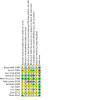
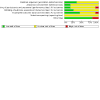

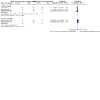
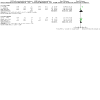



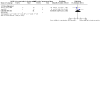
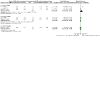
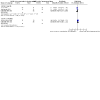
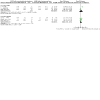


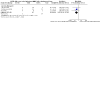
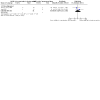
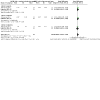
Update of
- doi: 10.1002/14651858.CD012946
References
References to studies included in this review
Buzzonetti 2008 {published data only}
-
- Buzzonetti L, Petrocelli G, Valente P, Tamburrelli C, Mosca L, Laborante A, et al. Comparison of corneal aberration changes after laser in situ keratomileusis performed with mechanical microkeratome and IntraLase femtosecond laser: 1-year follow-up. Cornea 2008;27(2):174-9. - PubMed
Durrie 2005 {published data only}
-
- Durrie DS, Kezirian GM. Femtosecond laser versus mechanical keratome flaps in wavefront-guided laser in situ keratomileusis: prospective contralateral eye study. Journal of Cataract and Refractive Surgery 2005;31(1):120-6. - PubMed
Gui‐Hong 2018 {published data only}
-
- Gui-Hong Xu, Zhen-Zhen Wu, Xiao-Hong Gu. Influence of microkeratome and femtosecond laser on vision and corneal flap thickness used in corneal flap making. Guoji Yanke Zazhi 2018;18(5):894-6.
Hasimoto 2013 {published data only}
-
- Hasimoto AR, Gomes MF, Siqueira MA, Moreira H. Femtosecond laser versus mechanical microkeratome for LASIK flap creation. Arquivos Brasileiros de Oftalmologia 2013;76(6):335-8. - PubMed
Manche_group 2008 {published data only}
-
- Chan A, Ou J, Manche EE. Comparison of the femtosecond laser and mechanical keratome for laser in situ keratomileusis. Archives of Ophthalmology 2008;126(11):1484-90. - PubMed
-
- Golas L, Manche EE. Dry eye after laser in situ keratomileusis with femtosecond laser and mechanical keratome. Journal of Cataract and Refractive Surgery 2011;37(8):1476-80. - PubMed
Patel_group 2010 {published data only}
-
- Patel SV, Maguire LJ, McLaren JW, Hodge DO, Bourne WM. Femtosecond laser versus mechanical microkeratome for LASIK: a randomized controlled study. Ophthalmology 2007;114(8):1482-90. - PubMed
Salomão 2009 {published data only}
Tan 2007 {published data only}
-
- Tan CS, Au Eong KG, Lee HM. Visual experiences during different stages of LASIK: Zyoptix XP microkeratome vs IntraLase femtosecond laser. American Journal of Ophthalmology 2007;143(1):90-6. - PubMed
Tran 2005 {published data only}
-
- Tran DB, Sarayba MA, Bor Z, Garufis C, Duh YJ, Soltes CR, et al. Randomized prospective clinical study comparing induced aberrations with IntraLase and Hansatome flap creation in fellow eyes: potential impact on wavefront-guided laser in situ keratomileusis. Journal of Cataract and Refractive Surgery 2005;31(1):97-105. - PubMed
Zhai 2013 {published data only}
-
- Zhai CB, Tian L, Zhou YH, Zhang QW, Zhang J. Comparison of the flaps made by femtosecond laser and automated keratomes for sub-bowman keratomileusis. Chinese Medical Journal 2013;126(13):2440-4. - PubMed
Zhou 2012 {published data only}
-
- Zhou Y, Zhang J, Tian L, Zhai C. Comparison of the Ziemer FEMTO LDV femtosecond laser and Moria M2 mechanical microkeratome. Journal of Refractive Surgery 2012;28(3):189-94. - PubMed
References to studies excluded from this review
AlArfaj 2014 {published data only}
Alió 2008 {published data only}
-
- Alió Jl, Piñero DP. Very high-frequency digital ultrasound measurement of the LASIK flap thickness profile using the IntraLase femtosecond laser and M2 and Carriazo-Pendular microkeratomes. Journal of Refractive Surgery 2008;24(1):12-23. - PubMed
Avetisov 2016 {published data only}
-
- Avetisov SE, Mamikonyan VR, Shmeleva-Demir OA, Karamyan AA, Bubnova IA, Kazaryan EE, et al. Intraocular pressure, ocular blood flow, and corneal biomechanics changes after LASIK surgery for myopia. Vestnik Oftalmologii 2016;132(4):24-8. - PubMed
Brar 2008 {published data only}
-
- Brar GS, Grewal DS, Jain R, Grewal SP. Changes in elevation and corneal volume following LASIK with flap creation using IntraLase, mechanical keratome and LASEK. Investigative Ophthalmology and Visual Science 2008;49:ARVO E – abstract 2441.
Cañadas 2013 {published data only}
-
- Cañadas P, Benito-Llopis L, Hernández-Verdejo JL, Teus MA. Comparison of keratocyte density after femtosecond laser vs mechanical microkeratome from 3 months up to 5 years after LASIK. Graefe's Archive for Clinical and Experimental Ophthalmology 2013;251(9):2171-9. - PubMed
Cosar 2013 {published data only}
Elmohamady 2018 {published data only}
Erie 2006 {published data only}
-
- Erie JC, Patel SV, McLaren JW, Bourne WM. Corneal nerve morphology and function after bladeless and microkeratome LASIK. A randomized-controlled study. Investigative Ophthalmology and Visual Science 2006;47:ARVO E – abstract 516.
Grewal 2011 {published data only}
-
- Grewal DS, Brar GS, Grewal SP. Posterior corneal elevation after LASIK with three flap techniques as measured by Pentacam. Journal of Refractive Surgery 2011;27(4):261-8. - PubMed
Hamilton 2008 {published data only}
-
- Hamilton DR, Johnson RD, Lee N, Bourla N. Differences in the corneal biomechanical effects of surface ablation compared with laser in situ keratomileusis using a microkeratome or femtosecond laser. Journal of Cataract and Refractive Surgery 2008;34(12):2049-56. - PubMed
He 2017 {published data only}
-
- He F, Tan HX. Comparative study of clinical efficacy after LASIK with corneal flap created by femtosecond laser and microkeratome. International Eye Science 2017;17(11):2120-22.
Hosny 2013 {published data only}
Hu 2015 {published data only}
-
- Hu L, Xie W, Tang L, Chen J, Zhang D, Yu P, et al. Corneal subbasal nerve density changes after laser in situ keratomileusis with mechanical microkeratome and femtosecond laser. Chung-Hua Yen Ko Tsa Chih 2015;51(1):39-44. - PubMed
Hussain 2015 {published data only}
-
- Hussain M, Tanaka TS, Greene JB, Mian S, Shtein RM. Long-term ocular surface outcomes and in vivo corneal confocal microscopy in patients with mechanical microkeratome vs femtosecond laser-assisted LASIK. Investigative Ophthalmology and Visual Science 2015;56(7):3912.
ISRCTN43661922 {published data only}
-
- ISRCTN43661922. Comparison of dry eye syndrome and corneal sensation after femtosecond- and microkeratome-assisted LASIK. isrctn.com/ISRCTN43661922 (first received 28 February 2011).
Jia 2014 {published data only}
-
- Jia BB, Zhang Y, Gao DM, Pang YZ. Changes of tear film after LASIK with corneal flap created by femtosecond laser and microkeratome. International Eye Science 2014;14(9):1730-2.
Jiang 2015 {published data only}
-
- Jiang HS, Wu WH, Wang WW. Visual quality analysis of femtosecond LASIK and iris location guided mechanical SBK for high myopia. International Eye Science 2015;15(7):1168-71.
Kanellopoulos 2013 {published data only}
-
- Kanellopoulos AJ, Asimellis G. Three-dimensional LASIK flap thickness variability: topographic central, paracentral and peripheral assessment, in flaps created by a mechanical microkeratome (M2) and two different femtosecond lasers (FS60 and FS200). Clinical Ophthalmology 2013;7:675-83. - PMC - PubMed
Kasetsuwan 2016 {published data only}
-
- Kasetsuwan N, Satitpitakul V, Puangsricharern V, Reinprayoon U, Pariyakanok L. Comparison of performances of femtosecond laser and microkeratome for thin-flap laser in situ keratomileusis. Lasers in Surgery and Medicine 2016;48(6):596-601. - PubMed
Kezirian 2004 {published data only}
-
- Kezirian GM, Stonecipher KG. Comparison of the IntraLase femtosecond laser and mechanical keratomes for laser in situ keratomileusis. Journal of Cataract and Refractive Surgery 2004;30(4):804-11. - PubMed
Kostin 2012 {published data only}
-
- Kostin OA, Rebrikov SV, Ovchinnikov AI, Stepanov AA. Corneal flap analysis after LASIK and femto-LASIK using optical coherence tomography and optical sections. Vestnik Oftalmologii 2012;128(5):3-5. - PubMed
Kouassi 2012 {published data only}
-
- Kouassi FX, Blaizeau M, Buestel C, Schweitzer C, Gallois A, Colin J, et al. Comparison of Lasik with femtosecond laser versus Lasik with mechanical microkeratome: predictability of flap depth, corneal biomechanical effects and optical aberrations. Journal Francais d'Ophtalmologie 2012;35(1):2-8. - PubMed
Krueger 2007 {published data only}
-
- Krueger RR, Dupps WJ Jr. Biomechanical effects of femtosecond and microkeratome-based flap creation: prospective contralateral examination of two patients. Journal of Refractive Surgery 2007;23(8):800-7. - PubMed
Lee 2005 {published data only}
-
- Lee HM, Koh A, Heng WJ, Fam HB. IntraLase femtosecond laser and hansatome microkeratome for LASIK: a comparative study. In: American Academy of Ophthalmology. 2005:240.
Lei 2016 {published data only}
-
- Lei XH, Yu CT, Zhang Y, Li J, Ma M. Effect of laser in situ keratomileusis with femtosecond laser on visual quality. International Eye Science 2016;16(6):1120-3.
Li 2007 {published data only}
-
- Li H, Sun T, Zhao J. Femtosecond laser vs. mechanical keratome in thin flap LASIK for correction of high myopia. In: American Academy of Ophthalmology. 2007:251.
Li 2010 {published data only}
-
- Li H, Sun T, Wang M, Zhao J. Safety and effectiveness of thin-flap LASIK using a femtosecond laser and microkeratome in the correction of high myopia in Chinese patients. Journal of Refractive Surgery 2010;26(2):99-106. - PubMed
Li 2012 {published data only}
-
- Li FS, Zhang J, Yin HZ, Zhou YH. Comparison of LASIK flap thickness created with Ziemer LDV femtosecond laser and Moria M2 mechanical microkeratome. International Eye Science 2012;12(6):1056-8.
Lian 2013 {published data only}
-
- Lian JC, Zhang SS, Zhang J, Ye S. Comparison of cornea flap made by femtosecond laser and microkeratome in laser in situ keratomileusis. Chung-Hua Yen Ko Tsa Chih 2013;49(4):305-8. - PubMed
Lim 2006 {published data only}
-
- Lim T, Yang S, Kim M, Tchah H. Comparison of the IntraLase femtosecond laser and mechanical microkeratome for laser in situ keratomileusis. American Journal of Ophthalmology 2006;141(5):833-9. - PubMed
Lin 2012 {published data only}
-
- Lin MY, Chang DC, Hsu WM, Wang IJ. Cox proportional hazards model of myopic regression for laser in situ keratomileusis flap creation with a femtosecond laser and with a mechanical microkeratome. Journal of Cataract and Refractive Surgery 2012;38(6):992-9. - PubMed
Lin 2016 {published data only}
Mai 2012 {published data only}
-
- Mai ZB, Liu SB, Nie XL, Tang XX, Xin BL. Comparative observation of confocal microscopy between femtosecond laser LASIK and Hansatome microkeratome LASIK. Zhonghua Shiyan Yanke Zazhi 2012;30(7):633-7.
Malhotra 2015 {published data only}
-
- Malhotra C, Jain AK, Veluswami J, Ram J, Gupta R, Kumar P. Higher order aberrations and visual outcomes in wavefront-optimized sub-Bowman keratomileusis: flap creation using femtosecond laser versus mechanical microkeratome. Asia-Pacific Journal of Ophthalmology 2015;4(4):197-203. - PubMed
Manche 2005 {published data only}
-
- Manche EE. A prospective randomized eye-to-eye comparison: IntraLase vs. hansatome in myopic LASIK with CustomVue. In: American Academy of Ophthalmology. 2005:174.
McLaren 2007 {published data only}
-
- McLaren JW, Patel SV, Nau CB, Winter EJ, Bourne WM. Corneal wavefront errors one year after LASIK: a paired comparison between flap cut with a femtosecond laser and with a mechanical microkeratome. Investigative Ophthalmology and Visual Science 2007;48:ARVO E – abstract 2360.
Medeiros 2007 {published data only}
-
- Medeiros FW, Stapleton WM, Hammel J, Krueger RR, Netto MV, Wilson SE. Wavefront analysis comparison of LASIK outcomes with the femtosecond laser and mechanical microkeratomes. Journal of Refractive Surgery 2007;23(9):880-7. - PubMed
Montés Micó 2007a {published data only}
-
- Montés-Micó R, Rodríguez-Galietero A, Alió JL, Cerviño A. Contrast sensitivity after LASIK flap creation with a femtosecond laser and a mechanical microkeratome. Journal of Refractive Surgery 2007;23(2):188-92. - PubMed
Montés Micó 2007b {published data only}
-
- Montés-Micó R, Rodríguez-Galietero A, Alió JL. Femtosecond laser versus mechanical keratome LASIK for myopia. Ophthalmology 2007;114(1):62-8. - PubMed
Muñoz 2010 {published data only}
-
- Muñoz G, Albarrán-Diego C, Ferrer-Blasco T, García-Lázaro S, Cerviño-Expósito A. Long-term comparison of corneal aberration changes after laser in situ keratomileusis: mechanical microkeratome versus femtosecond laser flap creation. Journal of Cataract and Refractive Surgery 2010;36(11):1934-44. - PubMed
Nau 2006 {published data only}
-
- Nau CB, McLaren JW, Maguire LJ, Patel, SV, Bourne WM. Keratocyte density after LASIK: does cutting the flap with a femtosecond laser make a difference? Investigative Ophthalmology and Visual Science 2006;47:ARVO E – abstract 542.
Nau 2007 {published data only}
-
- Nau CB, Patel SV, McLaren JW, Maguire LJ, Bourne WM. Central epithelial and flap thickness after LASIK: femtosecond laser vs. mechanical microkeratome. Investigative Ophthalmology and Visual Science 2007;48:ARVO E – abstract 5329.
NCT03193411 {published data only}
-
- NCT03193411. Visumax femtolasik versus moria M2 microkeratome in myopia. clinicaltrials.gov/ct2/show/NCT03193411 (first received 20 June 2017).
NCT03484468 {published data only}
-
- NCT03484468. Femtosecond laser versus microkeratome in creating corneal flaps in LASIK. clinicaltrials.gov/ct2/show/NCT03484468 (first received 30 March 2018).
NCT03597906 {published data only}
-
- NCT03597906. Topography guided LASIK by different protocols for treatment of astigmatism. clinicaltrials.gov/ct2/show/NCT03597906 (first received 24 July 2018).
Patel 2006 {published data only}
-
- Patel SV, McLaren JW, Maguire LJ, Bourne WM. A randomized-controlled study of bladeless and microkeratome LASIK. Investigative Ophthalmology and Visual Science 2006;47:ARVO E – abstract 4331.
Patel 2008 {published data only}
-
- Patel S, Alió JL, Artola A. Changes in the refractive index of the human corneal stroma during laser in situ keratomileusis. Effects of exposure time and method used to create the flap. Journal of Cataract and Refractive Surgery 2008;34(7):1077-82. - PubMed
Rosa 2009 {published data only}
-
- Rosa AM, Neto Murta J, Quadrado MJ, Tavares C, Lobo C, Van Velze R, et al. Femtosecond laser versus mechanical microkeratomes for flap creation in laser in situ keratomileusis and effect of postoperative measurement interval on estimated femtosecond flap thickness. Journal of Cataract and Refractive Surgery 2009;35(5):833-8. - PubMed
Shetty 2012 {published data only}
-
- Shetty R, Malhotra C, D'Souza S, Wadia K. WaveLight FS200 vs Hansatome LASIK: intraoperative determination of flap characteristics and predictability by hand-held bioptigen spectral domain ophthalmic imaging system. Journal of Refractive Surgery 2012;28(11 Suppl):S815-20. - PubMed
Sonigo 2006 {published data only}
-
- Sonigo B, Iordanidou V, Chong-Sit D, Auclin F, Ancel JM, Labbé A, et al. In vivo corneal confocal microscopy comparison of IntraLase femtosecond laser and mechanical microkeratome for laser in situ keratomileusis. Investigative Ophthalmology and Visual Science 2006;47(7):2803-11. - PubMed
Torky 2017 {published data only}
von Jagow 2009 {published data only}
-
- Jagow B, Kohnen T. Corneal architecture of femtosecond laser and microkeratome flaps imaged by anterior segment optical coherence tomography. Journal of Cataract and Refractive Surgery 2009;35(1):35-41. - PubMed
Xia 2015 {published data only}
Xie 2014 {published data only}
-
- Xie W, Zhang D, Chen J, Liu J, Yu Y, Hu L. Tear menisci after laser in situ keratomileusis with mechanical microkeratome and femtosecond laser. Investigative Ophthalmology and Visual Science 2014;55(9):5806-12. - PubMed
Zhang 2011 {published data only}
-
- Zhang ZH, Jin HY, Suo Y, Patel SV, Montés-Micó R, Manche EE, et al. Femtosecond laser versus mechanical microkeratome laser in situ keratomileusis for myopia: metaanalysis of randomized controlled trials. Journal of Cataract and Refractive Surgery 2011;37(12):2151-9. - PubMed
Zhang 2012 {published data only}
-
- Zhang F, Deng S, Guo N, Wang M, Sun X. Confocal comparison of corneal nerve regeneration and keratocyte reaction between FS-LASIK, OUP-SBK, and conventional LASIK. Investigative Ophthalmology and Visual Science 2012;53(9):5536-44. - PubMed
Zhang 2013 {published data only}
-
- Zhang Y, Chen YG, Xia YJ. Comparison of corneal flap morphology using AS-OCT in LASIK with the WaveLight FS200 femtosecond laser versus a mechanical microkeratome. Journal of Refractive Surgery 2013;29(5):320-4. - PubMed
References to ongoing studies
PACTR201708002498199 {published data only}
-
- PACTR201708002498199. Mechanical versus femtolaser corneal flaps assessment. pactr.samrc.ac.za/TrialDisplay.aspx?TrialID=2498 (first received 3 August 2017).
Additional references
Ang 2009
-
- Ang EK, Couper T, Dirani M, Vajpayee RB, Baird PN. Outcomes of laser refractive surgery for myopia. Journal of Cataract and Refractive Surgery 2009;35(5):921-33. - PubMed
Azar 2002
-
- Azar DT, Koch D. LASIK (Laser in Situ Keratomileusis): Fundamentals, Surgical Techniques, and Complications. Boca Raton (FL): CRC Press, 2002.
Azar 2006
-
- Azar DT, Gatinel D, Hoang-Xuan T. Refractive Surgery. 2nd edition. St Louis (MO): Elsevier Mosby, 2006.
Azar 2019
-
- Azar DT. Refractive Surgery E-Book. Elsevier Health Sciences, 2019.
Bashir 2017
-
- Bashir ZS, Ali MH, Anwar A, Ayub MH, Butt NH. Femto-LASIK: the recent innovation in laser assisted refractive surgery. Journal of the Pakistan Medical Association 2017;67(4):609-15. - PubMed
Bower 2001
-
- Bower KS, Weichel ED, Kim TJ. Overview of refractive surgery. American Family Physician 2001;64(7):1183-90. - PubMed
Chaurasia 2010
-
- Chaurasia SS, Luengo Gimeno F, Tan K, Yu S, Tan DT, Beuerman RW, et al. In vivo real-time intraocular pressure variations during LASIK flap creation. Investigative Ophthalmology and Visual Science 2010;51(9):4641-5. - PubMed
Chen 2012
-
- Chen S, Feng Y, Stojanovic A, Jankov MR 2nd, Wang Q. IntraLase femtosecond laser vs mechanical microkeratomes in LASIK for myopia: a systematic review and meta-analysis. Journal of Refractive Surgery 2012;28(1):15-24. - PubMed
Corcoran 2015
-
- Corcoran KJ. Macroeconomic landscape of refractive surgery in the United States. Current Opinion in Ophthalmology 2015;26(4):249-54. - PubMed
Courtin 2015
-
- Courtin R, Saad A, Guilbert E, Grise-Dulac A, Gatinel D. Opaque bubble layer risk factors in femtosecond laser-assisted LASIK. Journal of Refractive Surgery 2015;31(9):608-12. - PubMed
Covidence [Computer program]
-
- Veritas Health Innovation Covidence. Melbourne, Australia: Veritas Health Innovation, accessed after 13 December 2018.Available at covidence.org.
Farjo 2013
-
- Farjo AA, Sugar A, Schallhorn SC, Majmudar PA, Tanzer DJ, Trattler WB, et al. Femtosecond lasers for LASIK flap creation: a report by the American Academy of Ophthalmology. Ophthalmology 2013;120(3):e5-20. - PubMed
Flanagan 2003
-
- Flanagan GW, Binder PS. Precision of flap measurements for laser in situ keratomileusis in 4428 eyes. Journal of Refractive Surgery 2003;19(2):113-23. - PubMed
Gatinel 2013
-
- Gatinel D, Saad A, Guilbert E, Rouger H. Unilateral rainbow glare after uncomplicated femto-LASIK using the FS-200 femtosecond laser. Journal of Refractive Surgery 2013;29(7):498-501. - PubMed
Gil‐Cazorla 2011
-
- Gil-Cazorla R, Teus MA, Benito-Llopis L, Mikropoulos DG. Femtosecond laser vs mechanical microkeratome for hyperopic laser in situ keratomileusis. American Journal of Ophthalmology 2011;152(1):16-21.e2. - PubMed
GRADEpro 2015 [Computer program]
-
- McMaster University (developed by Evidence Prime) GRADEpro GDT. Version accessed 17 December 2018. Hamilton (ON): McMaster University (developed by Evidence Prime), 2015.Available at gradepro.org.
Higgins 2017
-
- Higgins JP, Altman DG, Sterne JA, editor(s). Chapter 8: Assessing risk of bias in included studies. In: Higgins JP, Churchill R, Chandler J, Cumpston MS, editor(s). Cochrane Handbook for Systematic Reviews of Interventions version 5.2.0 (updated June 2017). The Cochrane Collaboration, 2017. Available from www.training.cochrane.org/handbook.
Holden 2016
-
- Holden BA, Fricke TR, Wilson DA, Jong M, Naidoo KS, Sankaridurg P, et al. Global prevalence of myopia and high myopia and temporal trends from 2000 through 2050. Ophthalmology 2016;123(5):1036-42. - PubMed
Huhtala 2016
Issa 2011
-
- Issa A, Al Hassany U. Femtosecond laser flap parameters and visual outcomes in laser in situ keratomileusis. Journal of Cataract and Refractive Surgery 2011;37(4):665-74. - PubMed
Lubatschowski 2000
-
- Lubatschowski H, Maatz G, Heisterkamp A, Hetzel U, Drommer W, Welling H, et al. Application of ultrashort laser pulses for intrastromal refractive surgery. Graefes Archive for Clinical and Experimental Ophthalmology 2000;238(1):33-9. - PubMed
Medeiros 2011
Moher 2009
Morgan 2012
-
- Morgan IG, Ohno-Matsui K, Saw SM. Myopia. Lancet 2012;379(9827):1739-48. - PubMed
Moshirfar 2010
-
- Moshirfar M, Gardiner JP, Schliesser JA, Espandar L, Feiz V, Mifflin MD, et al. Laser in situ keratomileusis flap complications using mechanical microkeratome versus femtosecond laser: retrospective comparison. Journal of Cataract and Refractive Surgery 2010;36(11):1925-33. - PubMed
NASEM 2016
-
- National Academies of Sciences, Engineering, Medicine, Teutsch SM, McCoy MA, Woodbury RB, Welp A, editor(s). Making Eye Health a Population Health Imperative: Vision for Tomorrow. Washington (DC): National Academies Press, 2016. - PubMed
Randleman 2012
Review Manager 2014 [Computer program]
-
- Nordic Cochrane Centre, The Cochrane Collaboration Review Manager 5 (RevMan 5). Version 5.3. Copenhagen: Nordic Cochrane Centre, The Cochrane Collaboration, 2014.
Riordan‐Eva 2011
-
- Riordan-Eva P. Chapter 21. Optics & refraction. In: Riordan-Eva P, Emmett CT, editors(s). Vaughan & Asbury's General Ophthalmology. 18th edition. New York (NY): McGraw-Hill Companies, 2011.
Sales 2016
Salomao 2010
Smith 2009
Stonecipher 2006
-
- Stonecipher KG, Dishler JG, Ignacio TS, Binder PS. Transient light sensitivity after femtosecond laser flap creation: clinical findings and management. Journal of Cataract and Refractive Surgery 2006;32(1):91-4. - PubMed
References to other published versions of this review
Kahuam‐López 2018
-
- Kahuam-López N, Navas A, Castillo-Salgado C, Graue-Hernandez EO, Jimenez-Corona A, Ibarra A. Femtosecond laser versus mechanical microkeratome use for laser-assisted in-situ keratomileusis (LASIK). Cochrane Database of Systematic Reviews 2018, Issue 2. [DOI: 10.1002/14651858.CD012946] - DOI - PMC - PubMed
Publication types
MeSH terms
Grants and funding
LinkOut - more resources
Full Text Sources

